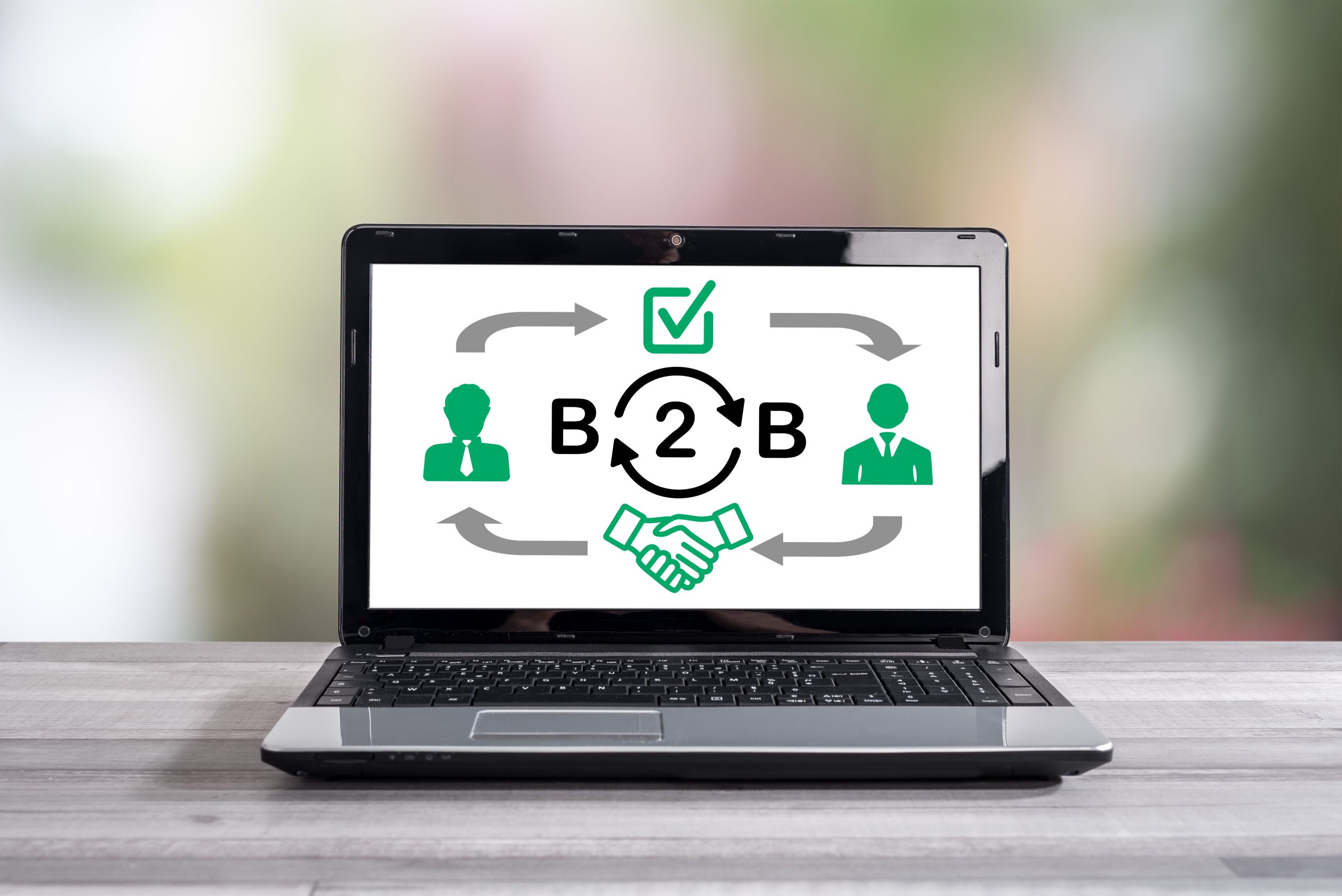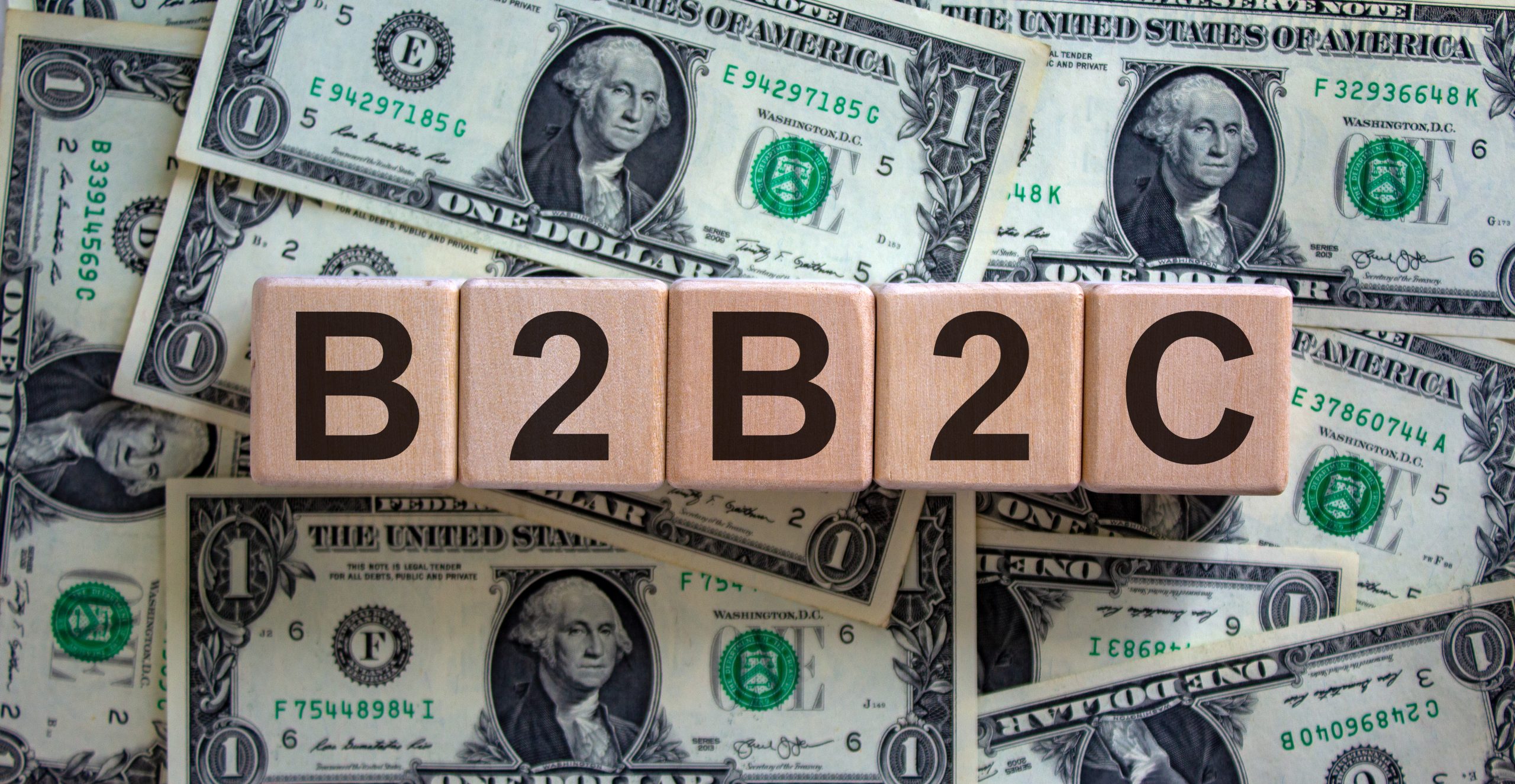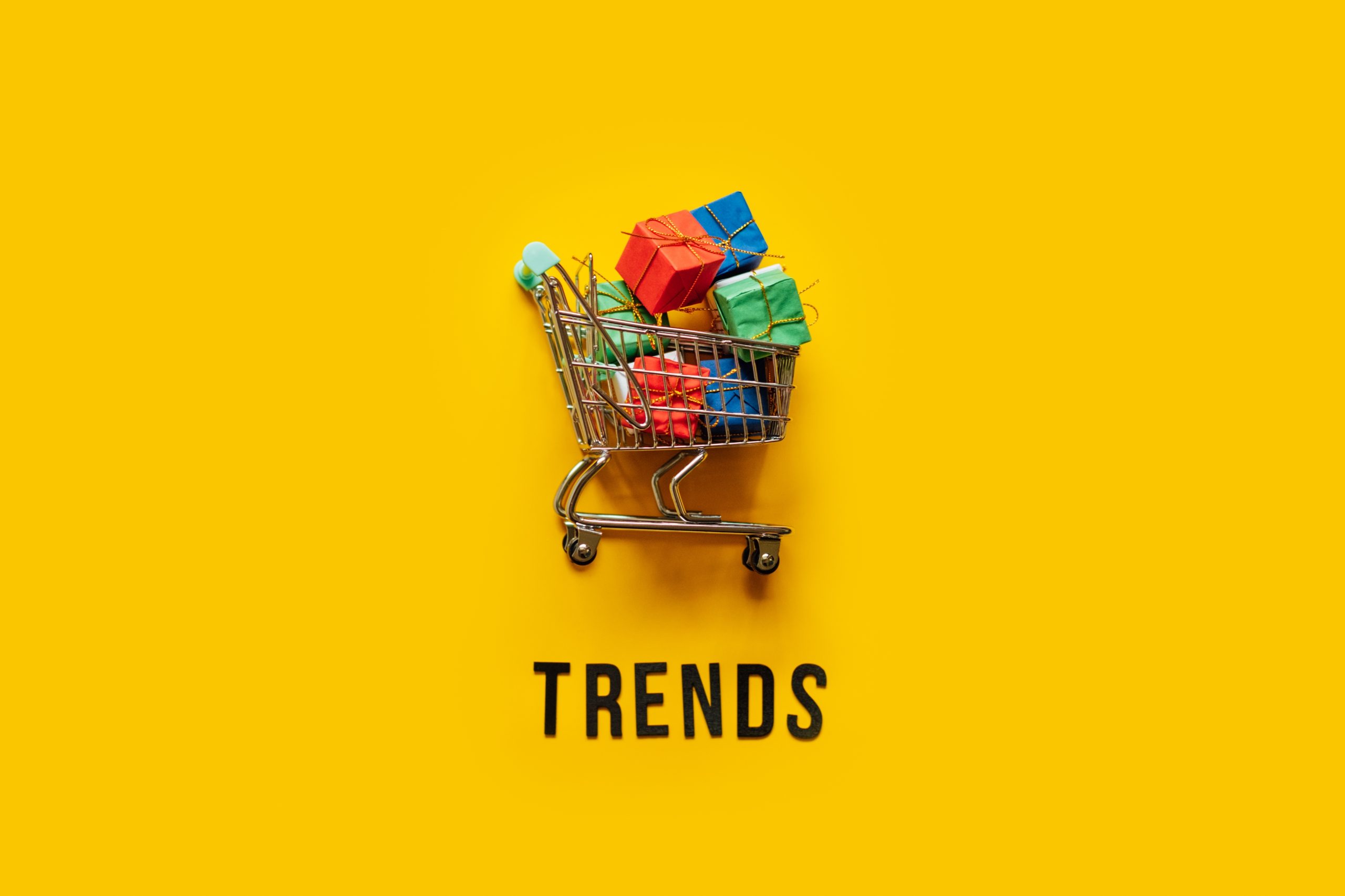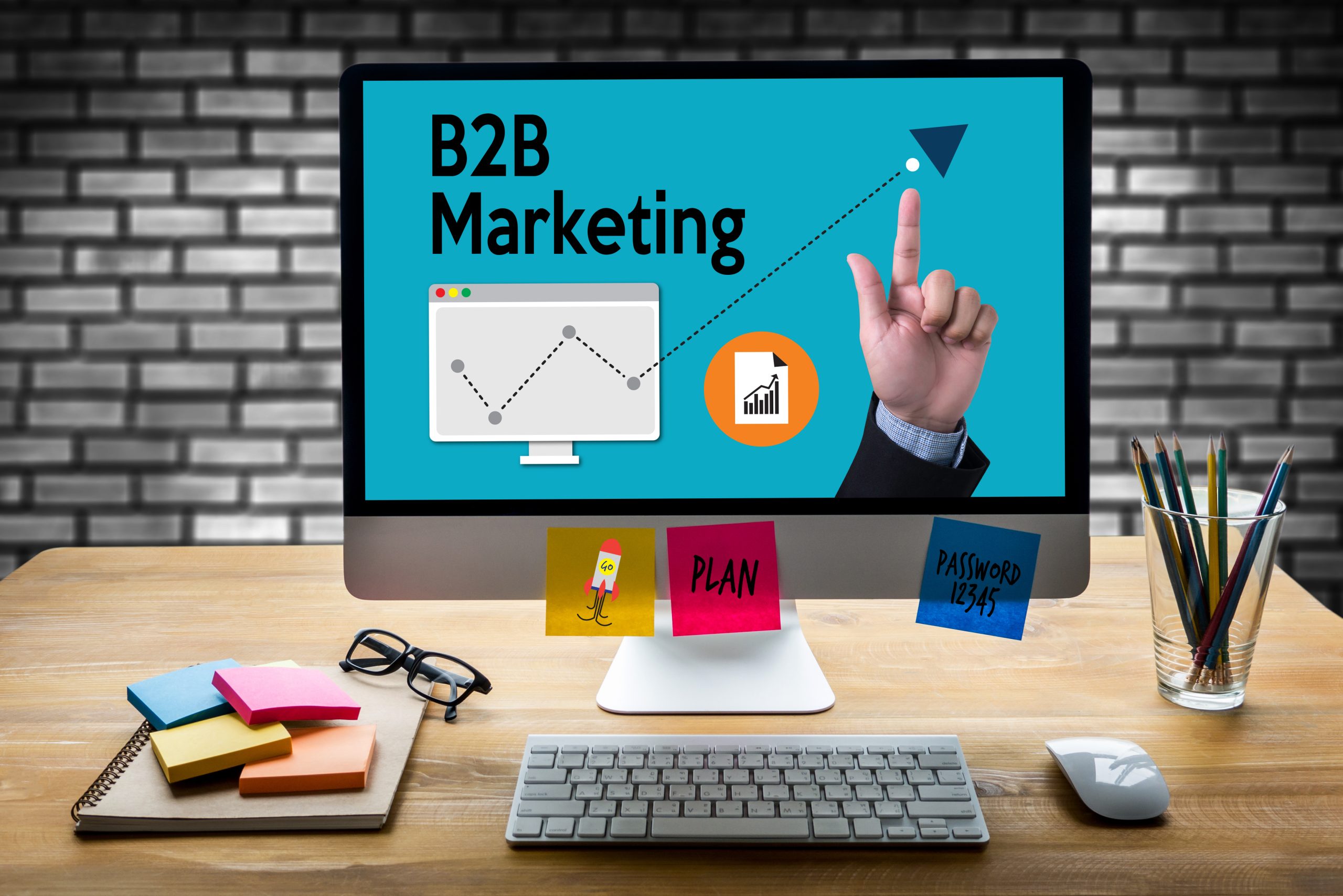B2B ecommerce: Insights and strategies for success
Explore the transformative potential of Shopify’s multiple warehouses in this comprehensive guide that delves into the strategies for streamlining operations and enhancing efficiency across multiple locations, paving the way for business growth and customer satisfaction.

Henry Kivimaa

When hearing the term ecommerce, most of us imagine browsing an Amazon storefront offering bulk deals on batteries or Hawaiian shirts, or looking through Wish.com for some exorbitantly cheap and weird-looking contraptions. However, there’s a sophisticated side to online business that goes beyond late-night impulse purchases and the hunt for the best deals.
Welcome to the world of B2B ecommerce, where companies are quietly revolutionizing the way they operate, trade, and collaborate.
Before the digital transformation brought about by the advent of electronic data interchange (EDI) systems in the late 1960s, B2B transactions were largely manual and cumbersome. Businesses relied on paper-based processes or cold calling, with orders, invoices, and payments being handled physically, which was both time-consuming and error-prone.
This innovation marked the beginning of digital business transactions, paving the way for today’s ecommerce platforms. It was born out of necessity — to reduce costs, improve transaction speeds, and expand market reach. Ultimately, B2B transactions became a big part of global commerce.
As the internet became widely accessible in the 1990s, B2B ecommerce saw another leap forward with the creation of online marketplaces. The new digital presence of businesses facilitated direct sales and expanded market reach globally.
In the early 2000s, it became possible to integrate ecommerce platforms with back-end systems like ERP (enterprise resource planning) and CRM (customer relationship management), enhancing efficiency and data accuracy. This period also saw the rise of cloud computing, making ecommerce more scalable and cost-effective. The rise of mobile technology and apps further expanded access and convenience for B2B transactions.
Today, B2B ecommerce software uses AI and machine learning for personalized experiences, predictive analytics, and automated customer service, introducing more intelligent and user-friendly systems. The future of B2B ecommerce will see more integration with emerging technologies, such as blockchain for secure transactions and IoT (internet of things) for improved supply chain management. This signals an ongoing evolution towards more interconnected, efficient, and sophisticated B2B ecommerce ecosystems.
As you may have guessed, this article is all about business-to-business online transactions, exploring the intricacies and advantages that make it more than just a digital shopping spree. So, postpone that online shopping for now as we dive into the world of B2B ecommerce.
What is B2B ecommerce?
B2B ecommerce, or business-to-business electronic commerce, is the online sale and purchase of goods and services between businesses. Unlike B2C (business-to-consumer) ecommerce, which facilitates deals between companies and individual consumers, B2B ecommerce typically involves transactions between manufacturers, wholesalers, distributors, and retailers.
These transactions often involve larger volumes, higher values, and more complex processes than B2C transactions.
B2B ecommerce allows businesses to streamline their purchasing and sales operations by automating order processing, payment transactions, logistics management, and other business functions.
Key features of B2B ecommerce include:
- Bulk ordering — Businesses often purchase large quantities, requiring features to manage bulk orders efficiently.
- Custom pricing — Prices can vary based on the buyer’s relationship, purchase history, order volume, and negotiated contracts.
- Account management — B2B platforms often offer tools to manage accounts, including order history, tracking, and custom catalogs.
- Complex payment options — Payment terms can be more complicated, including net terms, purchase orders, and leasing options.
- Integration capabilities — For seamless operations, B2B platforms must integrate with different business systems, such as ERP, CRM, and SCM (supply chain management).
The main goal of B2B ecommerce is to improve the efficiency and effectiveness of the supply chain and business operations. This, in turn, enables companies to cut back on costs, improve customer service, and create new sales channels.

What’s the difference between B2B and B2C ecommerce?
The obvious difference is that in B2B ecommerce, both parties are companies. But besides that, there are many other factors making it very different from B2C. Here are the main ones setting these approaches apart:
- Purchasing motivation
- Decision-makers
- Relationship duration
- Prices
- Payment terms
- Shipping terms
Purchasing motivation
In B2C transactions, buyers often make impulsive decisions driven by emotions or immediate needs. On the other hand, B2B buyers are more strategic, planning purchases carefully and engaging in recurring, planned transactions.
Decision-makers
Individual consumers typically make purchasing decisions on their own.
Every now and again, a husband will discuss with their spouse first, eloquently presenting their arguments as to why they need to purchase the $900 leafblower even though they live in an apartment. However, if this doesn’t yield the required results, the husband may still pull the trigger on the purchase and hide the leaf blower at a friend’s place where he can go and play with it every now and again.
The B2B decision-making process usually involves multiple stakeholders. This can include multiple departments and navigating through several levels of approval.
Relationship duration
Consumer purchases are often single transactions with no expectation of future interaction. On the other hand, business transactions are built on the foundation of long-term partnerships, where ongoing collaboration and repeat business are standard.
Pricing structure
Consumer pricing is generally straightforward and set at a fixed rate, unless you’re traveling around the Eastern world, where haggling is a way of life. Business pricing, however, is more dynamic, and some negotiation is expected. This is mostly due to the personalized contracts adapted to the specific needs of the business.
Payment terms
In consumer markets, you pay before receiving the product. The transaction is generally completed with credit or debit cards, or digital wallets. Business transactions, however, tend to offer more lenient payment terms. Companies often request the payment to be made within one month of receiving the goods. This helps to accommodate budgetary and cash flow considerations.
Shipping terms
Consumers value rapid delivery, often seeking the quickest possible shipping options with half the world being subscribed to Amazon Prime. Businesses, in contrast, prioritize delivery reliability and scheduling accuracy, ensuring that shipments align with their operational schedules and inventory needs.
As you can see, while the transaction of trading money for goods itself is similar, the exact process can vary wildly.
Types of B2B ecommerce
B2B ecommerce can take many forms, including manufacturers, wholesalers, and distributors. Each presents its own unique opportunities and challenges. It’s important to know the differences to ensure you can get the most out of your B2B digital marketplace.

B2B2C (business-to-business-to-consumer)
In the B2B2C model, businesses act as intermediaries, connecting other businesses with end consumers. This collaboration often involves virtual storefronts or applications, serving as a bridge between suppliers or manufacturers and the final consumer. Think of platforms like DoorDash or Amazon.
This type of B2B ecommerce allows businesses to expand their reach beyond traditional B2B transactions, tapping into end-consumer markets without directly managing consumer-facing operations. It facilitates seamless transactions, benefiting both the seller and the end consumer.
Wholesale
The wholesale B2B ecommerce model revolves around bulk purchasing for resale. Businesses, particularly retailers, buy products in large quantities from wholesalers. One of the biggest B2B ecommerce wholesalers is Alibaba.
This type is fundamental in industries where volume plays a crucial role in pricing and profitability. Wholesale transactions often lead to cost savings for retailers, enabling them to meet consumer demands with a robust inventory bought at discounted rates.
Distributors
Distributors in B2B ecommerce play a pivotal role by collaborating with manufacturers to sell products to businesses. Acting as intermediaries, distributors connect manufacturers with a broader audience of potential buyers. They help businesses purchase a wide range of products from different manufacturers through a single source.
Their role is essential in optimizing supply chains and ensuring efficient product distribution within the B2B ecosystem.
So, what exactly is the difference between wholesalers and distributors?
The main difference is that wholesalers have a closer relationship with retailers, while distributors are very close to the manufacturer. Distributors can help manufacturers with product promotion, offer customer support, and even influence product design.
Manufacturers
B2B ecommerce among manufacturers involves the direct production and sale of finished goods to other businesses. This model streamlines the supply chain, allowing manufacturers to reach a broader market of retailers, wholesalers, or distributors.
By dealing directly with other businesses, manufacturers have greater control over their distribution channels and can establish strategic partnerships for mutual growth. This type of B2B ecommerce is characterized by efficient supply chain management and direct business-to-business transactions.
Are you a manufacturer selling on Shopify?
Download our step-by-step guide on how to manage your Shopify store efficiently. Get an in-depth overview of the challenges and opportunities Shopify manufacturers face plus access to all the information you need to choose the right software for your needs.
Vertical and horizontal marketplaces
The last one in this list is B2B ecommerce marketplaces. These come in two main varieties:
- Vertical — Cater specifically to a particular industry, like electronics or chemicals, providing a targeted platform for businesses within that sector
- Horizontal — Cover a wide range of industries, offering a diverse selection of products and services
Both types of marketplaces connect buyers and sellers for efficient and targeted business transactions.
B2B auctions
B2B auctions provide a platform for businesses to bid on goods and services. This model encourages competition among buyers, ensures optimal pricing, and allows businesses to buy products or services through a transparent bidding process.
B2B auctions introduce a dynamic element to procurement. They provide businesses with opportunities to acquire items at competitive prices while promoting fair and open market transactions.
Like Amazon in the above example, businesses don’t have to stick to just one type of B2B ecommerce. In fact, most companies opt for multiple different B2B ecommerce strategies to reach a larger customer base.
The benefits of B2B ecommerce
Compared to regular business-to-business transactions, B2B ecommerce offers many benefits. Let’s dive into the biggest advantages that make this approach a game-changer for many companies.
Streamlined operations and efficiency
B2B ecommerce improves internal processes, reduces the need to manually intervene, and minimizes errors. Automating workflows, from processing orders to managing inventory, enhances operational efficiency, letting businesses use their resources more wisely and concentrate on their main strengths.
Expanded market reach and customer base
By adopting B2B ecommerce, companies can overcome geographical limitations through online platforms and get access to a wider market. This enables businesses to connect with customers worldwide, diversify their customer base, and enhance opportunities for global collaborations with partners and suppliers.
Enhanced customer experience and personalization
B2B ecommerce apps offer clients a personalized and user-friendly experience. From tailored product recommendations to intuitive interfaces, businesses can cater to individual needs, for happy and loyal customers.
The ability to customize offerings based on historical data further strengthens relationships and promotes long-term partnerships.
Streamlined sales and purchasing processes
The traditional sales and procurement cycles often involve complex negotiations and paperwork. B2B ecommerce simplifies these processes, providing a centralized platform where businesses can communicate, negotiate, and manage transactions. This results in quicker deal closures and improved procurement efficiency.
Enhanced data analysis and decision-making
Data is a cornerstone of modern business strategy, and B2B ecommerce excels in providing valuable insights. Through advanced analytics tools, businesses can gain a detailed understanding of customer behavior, market trends, and operational performance.
Informed decision-making becomes a strategic advantage, guiding businesses toward sustainable growth.
Scalability to grow with market demands
One of the standout features of B2B ecommerce is its inherent scalability. As businesses evolve and market demands fluctuate, these platforms can adapt and grow.
Whether handling increased transaction volumes, expanding product catalogs, or integrating with evolving technologies, B2B ecommerce systems provide the flexibility necessary to scale with business goals.
The benefits of B2B ecommerce extend far beyond transactional conveniences. They empower businesses to operate more efficiently, connect with a global audience, and intelligently navigate the complexities of modern commerce.

Challenges in B2B ecommerce and ways to overcome them
As with everything we do, encountering challenges in B2B ecommerce is inevitable. However, acknowledging and proactively addressing these challenges is the key to success.
This section explores some more prominent challenges in B2B ecommerce and provides actionable strategies to overcome them.
Complexity of B2B transactions
B2B transactions can be complex, involving detailed processes, negotiations, and numerous decision-makers. To simplify these transactions, businesses can use digital platforms that automate workflows, improve communication, and have user-friendly interfaces. Simplifying the process in this way increases efficiency and minimizes errors.
Managing customer relationships and expectations
Building and maintaining strong customer relationships is crucial in B2B ecommerce. Addressing the diverse needs and expectations of business clients requires a proactive approach.
The best bet is to implement a CRM system to track interactions, personalize communication, and anticipate client needs. Additionally, providing transparent and consistent communication fosters trust and strengthens long-term partnerships.
Navigating digital transformation
The fast pace of digital transformation can be challenging for businesses transitioning to B2B ecommerce. To overcome this challenge, companies should invest in comprehensive training programs for employees, making sure they are well-versed in the functionalities of the digital platform.
Additionally, it’s important for businesses to promote a culture of adaptability and continuous learning to successfully navigate the changing world of B2B ecommerce.
Ensuring data security and privacy
The more we rely on digital platforms, the more we need to invest in security and privacy. Implementing robust cybersecurity measures, including encryption protocols and secure payment gateways, is essential to safeguard sensitive information. Regular audits and compliance with industry standards further contribute to a secure B2B ecommerce environment.
Adapting to market shifts and trends
The business environment changes all the time due to new market trends and shifts. To stay competitive, companies need to be flexible and adaptable. Keeping up with market trends through ongoing analysis, staying informed about industry developments, and embracing new technologies proactively help businesses navigate these changes and achieve long-term success.
Click on the image below to explore the trends shaping the business world in 2024.
B2B ecommerce platforms
To start reaping the benefits and tackling the challenges of B2B ecommerce, you need a good toolset. In this case — a B2B ecommerce platform.
In this section, we take a closer look at B2B ecommerce platforms, which are crucial for keeping business operations connected and running smoothly. These platforms help companies manage transactions effortlessly, streamline their processes, and enhance the overall business environment. We’ll explore how these platforms function, highlight their key features, and point out what makes some stand out more than others.
What makes a great B2B ecommerce platform?
Selecting the right B2B ecommerce platform is like choosing a strategic partner for navigating the digital marketplace. A great platform is more than just a tool to simplify transactions. These platforms need to tie into your other business tools and offer features targeting the specific needs of B2B commerce companies.
Let’s explore the key elements that make a B2B e-commerce platform a great one.
User-friendly interface
You’ve probably used an app or visited a website only to close it in horror once everything loaded, as there was no rhyme or reason between any of the elements. Maybe it would’ve worked great, but a horrible user interface (UI) is enough to turn customers away before they even give your app a chance.
So don’t overlook the importance of good UI.
Clear navigation, well-organized menus, and an easily understandable layout all contribute to a positive user experience and ensure users give your software a chance.
Customization capabilities
Businesses vary in their structure, processes, and preferences. A robust B2B ecommerce platform should offer extensive customization capabilities. This enables companies to tailor the platform to their specific workflows and needs.
From personalized storefronts to configurable workflows, customization ensures that the platform aligns perfectly with the unique requirements of each business.
Comprehensive analytics and reporting
Informed decision-making relies on data insights. A top-tier B2B ecommerce platform provides comprehensive analytics and reporting tools, offering businesses real-time visibility into transactional data, customer behavior, and overall platform performance. This data-driven approach empowers businesses to refine strategies and enhance operational efficiency.
Scalability for growth
As businesses evolve and grow, the B2B ecommerce platform must keep up. Scalability is crucial, allowing the platform to handle increasing transaction volumes, product catalogs, and user interactions without compromising performance. This adaptability ensures the platform remains a reliable asset throughout the business’ expansion.
Integration with back-end systems
For streamlined operations, a great B2B ecommerce solution seamlessly integrates with existing back-end systems. These can include ERP systems and CRM platforms. This integration keeps your data consistent across different platforms, reduces human errors, and supports a unified business environment.
Advanced security measures
We mentioned it already above, but it really is important. Given the sensitive nature of B2B transactions, robust security measures are non-negotiable. The platform should employ encryption protocols, secure payment gateways, and regular security audits to safeguard sensitive business information and maintain the trust of all parties involved.
Mobile responsiveness
As a large part of business transactions occur on the go, a great B2B ecommerce platform must be mobile-friendly. This ensures users can access and engage with the platform seamlessly across various devices, promoting flexibility and convenience in business interactions.
Automated workflows
Efficiency is a hallmark of great B2B ecommerce software. Automating workflows, from order processing to invoicing, reduces manual intervention, minimizes errors, and accelerates transaction cycles. Automated processes contribute to streamlined operations and improved overall efficiency.
When demoing different B2B ecommerce platforms, keep these elements in mind, so you don’t have to start shopping for a new one in a few months.
Popular B2B ecommerce platforms
Now that you know what to look for in your new B2B ecommerce solution, let’s explore some of the most popular ones available right now.
BigCommerce
BigCommerce is known for its ease of use and scalability, making it a go-to for both small businesses and growing enterprises. It offers a wide range of built-in features and integrations, focusing on businesses looking to expand quickly without extensive custom development.
- Benefits — BigCommerce is praised for its ease of use, scalability, and comprehensive set of built-in features, suitable for businesses of all sizes.
- Unique aspects — Offers a balance between out-of-the-box functionality and customizable options without the need for extensive coding.
- Pricing — Custom pricing. The BigCommerce B2B Edition app starts from $500/month but needs the BigCommerce Enterprise plan.
Magento (Adobe Commerce)
Magento, now known as Adobe Commerce, is a highly customizable ecommerce platform suited for businesses looking to scale and have specific requirements. It’s particularly favored for its extensive feature set that supports complex online stores, multiple languages, and currencies, making it ideal for global ecommerce.
- Benefits — Magento offers a lot of customization options and a robust set of features. It’s ideal for businesses looking for deep integration capabilities and a scalable solution to grow with.
- Unique aspects — Its open-source nature allows for high customization, making it suitable for complex B2B operations.
- Pricing — Customized price based on annual GMV (gross merchandise value) and AOV (average order value).
Shopify Plus
Shopify Plus is the enterprise version of Shopify, designed for high-volume merchants. It offers simplicity, reliability, and scalability, with a focus on user-friendly experiences. This platform is perfect for businesses aiming for rapid growth without worrying about the technical complexities of running an online store.
- Benefits — Known for its ease of use, Shopify Plus provides a scalable platform for growing businesses. It offers reliable hosting, seamless upgrades, and robust security measures.
- Unique aspects — Shopify Plus stands out for its user-friendly interface and extensive app ecosystem, allowing businesses to easily add features.
- Pricing — Starts at $2,300/month for a 3-year commitment.
SAP Commerce Cloud
SAP Commerce Cloud is built for enterprises with complex business needs, offering a comprehensive suite of ecommerce tools. It integrates deeply with SAP’s ecosystem, providing robust solutions for omnichannel commerce, global expansion, and intricate product catalog management.
- Benefits — SAP Commerce Cloud caters to complex business models, offering comprehensive commerce solutions that support various business scenarios, including omnichannel retailing.
- Unique aspects — Integration with SAP’s suite of business applications, offering a powerful option for enterprises needing a holistic business solution.
- Pricing — Custom pricing based on the specific needs and scale of the business.
CS-Cart
CS-Cart stands out for its multi-vendor marketplace solution, allowing businesses to build a platform where multiple sellers can list their products. It’s designed for those looking to manage a marketplace or require a customizable, self-hosted ecommerce solution.
- Benefits — CS-Cart is designed for businesses looking for a self-hosted B2B ecommerce solution, offering great customization capabilities and control over the hosting environment.
- Unique aspects — It stands out for its multi-vendor functionality, allowing for the creation of an online marketplace where multiple sellers can manage sales through a single interface.
- Pricing — Starting from $1,250/year, also offers a lifetime license, differentiating it from other platforms.
This list is by no means exhaustive, so if you’re looking for more players in this segment, check out the dedicated article — Top 11 B2B ecommerce platforms for entrepreneurs in 2024
Regardless of which app you choose for your B2B ecommerce needs, it’s crucial that it connects seamlessly with your other tools. Katana Cloud Inventory Platform brings all your business services together. It offers features from inventory planning to production and sales management.
It seamlessly connects with the best B2B ecommerce software, accounting tools, and many more, acting as a centralized source of truth and ensuring all your data is synced across platforms.
To see how it can set your B2B ecommerce business up for success, reach out to us to get a demo.

B2B ecommerce trends and future outlook
To remain competitive, it’s important to be aware of the latest trends. That doesn’t mean everything has to have a touch screen and an AI. But you need to know what your users are excited about and are yearning for.
Mobile optimization
The surge in mobile commerce emphasizes the need for B2B ecommerce software to be optimized for mobile use. Ensuring that the online experience is seamless across devices has become critical, addressing the daily habits of the target audience and reducing bounce rates and abandoned carts.
Is mobile really important?
Worldwide mobile ecommerce sales reached $2.2 trillion in 2023. That’s 12 zeros. This means that 60% of ecommerce transactions take place on mobile. Just to be clear, this is mostly driven by consumer spending. But businesses are adopting mobile quite quickly themselves, so don’t be left behind.
Social commerce
Social platforms have added to their traditional roles and emerged as key channels for B2B transactions. Platforms like Instagram and TikTok offer new shopping options and elevate customer engagement through direct purchases, providing businesses with innovative avenues for reaching their audience.
Personalized online shopping
The demand for personalized shopping experiences continues to rise. Businesses leveraging customer data to tailor the online experience witness higher engagement and satisfaction. The ability to curate content, recommend products, and provide a personalized journey enhances the overall customer experience.
Omnichannel sales
Seamlessness across multiple channels has become a cornerstone of B2B ecommerce. Offering a consistent and connected customer journey, regardless of the channel, ensures that businesses meet the expectations of modern buyers who seamlessly switch between online and offline interactions.
Sustainability
The growing awareness of climate change is reshaping business practices. More companies are adopting eco-friendly measures, such as sustainable packaging and reduced energy consumption, or reforming their logistics strategy for a more sustainable supply chain.
Aligning with sustainability not only benefits the planet but also enhances the brand’s appeal to environmentally conscious customers.
Self-service customer portals
The trend toward digital self-service options is gaining momentum. B2B buyers increasingly value the autonomy of researching and purchasing products online without the need for direct sales interactions. Self-service customer portals offer efficiency and convenience in the procurement process.
Headless commerce
The separation of front-end and back-end systems, known as headless commerce, is providing businesses with increased flexibility and speed in deploying and updating their ecommerce experiences. This approach enables swift adaptation to changing market conditions and evolving customer preferences.
Efficient fulfillment and real-time inventory
As expectations for fast shipping rise, B2B companies are investing in automation and real-time inventory systems. These technologies expedite the fulfillment process and ensure accurate stock availability, contributing to enhanced customer satisfaction.
Augmented and virtual reality
AR and VR technologies are increasingly used to create immersive buying experiences. B2B buyers can better understand products and their functionality before making a purchase decision, creating a more informed and confident buying process.
Transparency and dynamic pricing
Transparency in pricing and operations is gaining prominence in the B2B ecommerce landscape. Dynamic pricing strategies, adapting to supply and demand changes in real-time, offer businesses agility in responding to market fluctuations.
These are all trends that you should be aware of. But as mentioned, it doesn’t mean you must implement everything immediately to stay relevant. So, be sure you understand your customers and their exact needs before changing your business practices.

12 key components of B2B ecommerce strategy
A well-defined and adaptive strategy can make or break a business. This section will explore the 12 essential components businesses should address when formulating a robust B2B ecommerce strategy.
1. Customer segmentation
Understanding the diverse needs of your customer base is fundamental. Effective customer segmentation enables businesses to tailor their offerings, marketing strategies, and user experiences to different segments, fostering stronger connections and satisfaction.
2. User experience (UX) design
The design of your B2B ecommerce software greatly influences user engagement. Prioritizing an intuitive and seamless user experience ensures that clients can easily navigate the platform, encouraging repeat business.
3. Integration with back-end systems
A unified digital ecosystem is crucial for streamlined operations. Integrate your B2B ecommerce solution with back-end systems, such as:
- ERP
- CRM
- Accounting software
Having your apps talk to each other improves efficiency, reduces mistakes, and promotes consistency in business operations.
4. Payment and security protocols
The handling of payments in B2B transactions requires advanced security measures. Make sure you have implemented secure payment gateways, encryption protocols, and other security features. Follow up on the latest data security best practices and compliance standards.
5. Content marketing and product information
Content plays a pivotal role in educating and persuading B2B buyers. A comprehensive content marketing strategy, coupled with detailed product information, helps businesses showcase their value proposition, build credibility, and assist buyers in making informed decisions.
6. Scalability and flexibility
The scalability of your B2B ecommerce solution is essential to accommodate growth and changing business needs. A strategy that allows for seamless scalability and flexibility ensures that the platform can adapt to increasing transaction volumes and expanding product catalogs.
7. Personalization and customization
Tailoring the customer experience through personalization and customization is a powerful strategy. It’s a big difference between these two emails:
- Dear valued user! We wanted to let you know about some new product offerings we have on sale. Take a look to see if you find anything you like.
- Hi Anthony! We noticed you’ve been searching for CNC router bits but haven’t made the purchase yet. I’m just letting you know that we currently have the following ones on sale that should perfectly suit your needs.
So, leverage your customer data to provide personalized recommendations, customized pricing, and tailored services to enhance customer satisfaction and create long-term relationships.
8. Supply chain optimization
Streamlining the supply chain is integral to efficient B2B transactions. Developing a strategy that optimizes the supply chain, from purchasing to fulfillment, enhances operational efficiency, and contributes to a reliable and consistent customer experience.
9. Data analytics and business intelligence
Informed decision-making relies on actionable insights. A robust strategy incorporates data analytics and business intelligence tools to extract valuable information on customer behavior, market trends, and platform performance, guiding strategic decisions for continued and sustainable growth.
10. Continuous innovation and adaptation
The digital landscape evolves rapidly, so don’t rest on your laurels. A forward-thinking strategy emphasizes continuous innovation and adaptation to emerging technologies and market trends. This proactive approach positions businesses to stay ahead of the curve and maintain a competitive edge.
But we need to mention it again — don’t just implement everything that becomes a trending topic on TikTok. Ensure that it actually delivers value to your clients.
11. Marketing and promotion
Crafting an effective B2B marketing and promotion strategy is crucial for increasing visibility and attracting potential clients. This includes targeted digital marketing campaigns, promotional activities, and leveraging various channels to reach your audience.
12. Post-purchase support and relationship building
The journey doesn’t end at the point of purchase. A great support team is what can turn a frustrating experience into a gloating review.
So, be sure you invest in post-purchase support and initiatives to build lasting relationships with clients. This may involve customer support, feedback mechanisms, and loyalty programs.
Focusing on these important elements of a B2B ecommerce strategy helps businesses effectively handle the challenges of the digital market, meet their clients’ specific needs, and achieve long-term success in B2B transactions.

B2B ecommerce marketing
Whether we like it or not, a lot of times, marketing is as important as the product itself. The days of “build it, and they will come” are long gone. The competition is fierce, and to gain customers, they have to know about your existence.
Unlike B2C marketing, B2B ecommerce presents unique challenges and opportunities that require tailored approaches. Here’s a list of considerations, differences, and timeless strategies for B2B ecommerce marketing.
1. Tailoring strategies to B2B dynamics:
- Understanding the audience — B2B marketing revolves around engaging with businesses as customers. It’s essential to understand their specific needs, pain points, and decision-making processes, as well as your value proposition.
- Targeted content — Create content that speaks directly to the challenges and goals of businesses. Provide in-depth product information, case studies, and whitepapers that resonate with a B2B audience.
- Personalized marketing — Tailor marketing messages based on the roles and responsibilities of the people involved in the buying process. Personalization enhances engagement and creates a sense of relevance.
2. How B2B marketing differs from B2C:
- Decision-making process — B2B purchases typically involve multiple decision-makers, each with specific roles and responsibilities. Understanding this complex decision-making process is crucial for crafting targeted marketing messages.
- Emphasis on relationships — B2B transactions often rely on long-term relationships and ongoing collaboration. Building and maintaining these relationships is a core aspect of B2B marketing, distinguishing it from the more transactional nature of B2C.
3. Timeless strategies for B2B ecommerce marketing:
- Content marketing — Develop high-quality, informative content that addresses the pain points and challenges of businesses. This not only establishes authority but also attracts businesses searching for solutions.
- Search engine optimization (SEO) — Optimize online content for search engines to enhance visibility. B2B buyers often conduct thorough research, making a strong online presence crucial for attracting and retaining customers.
- Email marketing — Use targeted email campaigns to nurture leads and keep businesses informed about product updates, industry trends, and exclusive offers.
- Social media engagement — Leverage social media platforms strategically. While B2B decisions are not typically made on social platforms, these channels serve as valuable tools for brand awareness, community building, and industry networking.
4. Embracing technological advancements:
- Implement ecommerce platforms — Choose a robust and scalable B2B ecommerce platform that aligns with business needs. Ensure it supports features such as personalized pricing, bulk ordering, and integration with other business systems.
- Leverage data analytics — Gather data to gain insights into customer behavior, preferences, and trends. This data-driven approach allows businesses to refine marketing strategies for optimal effectiveness.
Navigating the world of B2B ecommerce marketing involves more than just understanding the basics of business. It’s about getting to the heart of business dynamics, emphasizing relationship-building, and skillfully using digital tools and platforms. By crafting strategies that are specifically tailored to the unique demands of B2B transactions, businesses can build lasting relationships and successfully compete in the bustling digital marketplace.

B2B ecommerce statistics
It’s been a long read. Believe me, I know, I wrote it. So, let’s change it up a bit and take a look at some numbers that truly demonstrate the importance of B2B ecommerce.
Market size and growth:
- The global B2B ecommerce market was valued at $26.163 trillion in 2023, with projections indicating a surge to $56.921 trillion by 2028. This significant growth, averaging an 18.0% increase from 2022 to 2023, underscores the market’s expansive trajectory.¹
Digital adoption and preferences
- A staggering 83% of B2B buyers showed a preference for conducting purchases or payments through digital channels, illustrating a clear shift toward online transactions.²
- By 2025, it’s anticipated that 80% of B2B sales interactions between suppliers and buyers will occur in digital channels, signifying the increasing importance of digital platforms in the B2B sales process.²
Buyer behavior insights:
- In recent surveys focused on B2B buyers, approximately 49% indicated their preference for utilizing Google’s search engine when seeking out new items or products.³
- B2B buyers are now utilizing an average of 10 or more channels to engage with suppliers, up from five in 2016, highlighting the diverse and multichannel nature of modern B2B buying journeys.²
Ecommerce capabilities:
- Nearly two-thirds of B2B companies now offer ecommerce capabilities, an increase from 53% in early 2021, demonstrating the growing recognition of the importance of online sales channels.²
Millennial and Gen Z influence
- By 2024, 64% of B2B buyers are expected to be Millennials and Gen Z’ers, indicating a demographic shift that could influence buying patterns and preferences toward more digital, efficient, and personalized buying experiences.³
Website design and user experience:
- A significant 94% of first impressions are related to a website’s design, emphasizing the critical role of web design in attracting and retaining customers.³
- Slow-loading websites led to an estimated $2.6 billion in lost revenue in 2022, highlighting the impact of website performance on sales and customer satisfaction.³
These statistics paint a picture of a B2B ecommerce sector that is not only growing at a rapid pace but is also undergoing significant transformation. Businesses are increasingly leaning into online sales channels, prioritizing digital buyer experiences, and adapting to the preferences of a younger, more digitally savvy cohort of B2B buyers.
For companies operating in this space, staying ahead of these trends and adapting strategies accordingly will be key to capturing opportunities and driving growth in the coming years.
Keep your stock levels right
Katana Cloud Inventory Software is the ideal platform for B2B ecommerce companies looking to take control of their inventory.
B2B ecommerce FAQs
What is B2B ecommerce?
B2B ecommerce, or business-to-business electronic commerce, is the online buying and selling of goods and services between businesses. The transactions, therefore, take place between companies rather than involving individual consumers. B2B ecommerce platforms facilitate the exchange of products, services, and information, streamlining business processes and transactions between businesses.
How to choose a B2B ecommerce platform?
Choosing the right B2B ecommerce platform is crucial for the success of your business. Consider the following factors when making your decision:
- Scalability — Ensure the platform can accommodate your business growth.
- Customization — Look for platforms that offer customization options tailored to your specific B2B needs.
- Integration — Choose a platform that seamlessly integrates with your existing systems and software.
- Security — Prioritize platforms with robust security features to protect sensitive business data.
- User-friendly interface — Opt for a platform that is easy to navigate for both your team and potential buyers.
By evaluating these factors, you can select a B2B ecommerce platform that aligns with your business requirements and goals.
What is an Example of B2B ecommerce?
An exemplary instance of B2B ecommerce is the Alibaba platform. Alibaba, a global online marketplace, connects businesses and facilitates wholesale transactions between manufacturers, suppliers, and distributors worldwide.
Through Alibaba’s B2B ecommerce model, businesses can source products, negotiate deals, and conduct large-scale transactions within an online marketplace specifically designed for B2B interactions.
What are some types of B2B ecommerce?
B2B ecommerce encompasses a diverse array of models, each tailored to specific business dynamics and objectives:
B2B2C (business-to-business-to-consumer) — In this model, businesses serve as intermediaries, connecting other businesses with end consumers through virtual storefronts or applications. It involves a collaborative approach where the primary business acts as a bridge, facilitating transactions between suppliers or manufacturers and the final consumer.
Wholesale — Wholesale B2B ecommerce involves bulk purchasing for resale. Businesses, often retailers, buy products in large quantities from manufacturers or distributors at discounted rates. This model is prevalent in industries where volume plays a crucial role in pricing and profitability.
Distributors — Distributors in the B2B ecommerce landscape partner with manufacturers to sell products to businesses. Acting as intermediaries, distributors play a vital role in reaching a wider audience for manufacturers while providing businesses with a convenient source for procuring a diverse range of products.
Manufacturers — Manufacturers engaged in B2B ecommerce produce and sell finished goods directly to other businesses. This allows manufacturers to reach a broader market of retailers, wholesalers, or distributors.
Understanding these B2B ecommerce models allows businesses to strategically align their operations with the specific needs and dynamics of their industry, enabling efficient and streamlined transactions within the digital landscape.
Sources
¹B2B eCommerce Statistics, CapitalOne Shopping (2023)
²Be the smartest person in the Zoom: Top 10 B2B e-commerce stats to know, The Future of Commerce (2023)
³37 B2B Statistics and Trends in 2024, UserGuiding (2024)
⁴Global Mobile E-Commerce Worth $2.2 Trillion in 2023, Statista (2023)

Henry Kivimaa
Table of contents
Get inventory trends, news, and tips every month
Get visibility over your sales and stock
Wave goodbye to uncertainty with Katana Cloud Inventory — AI-powered for total inventory control